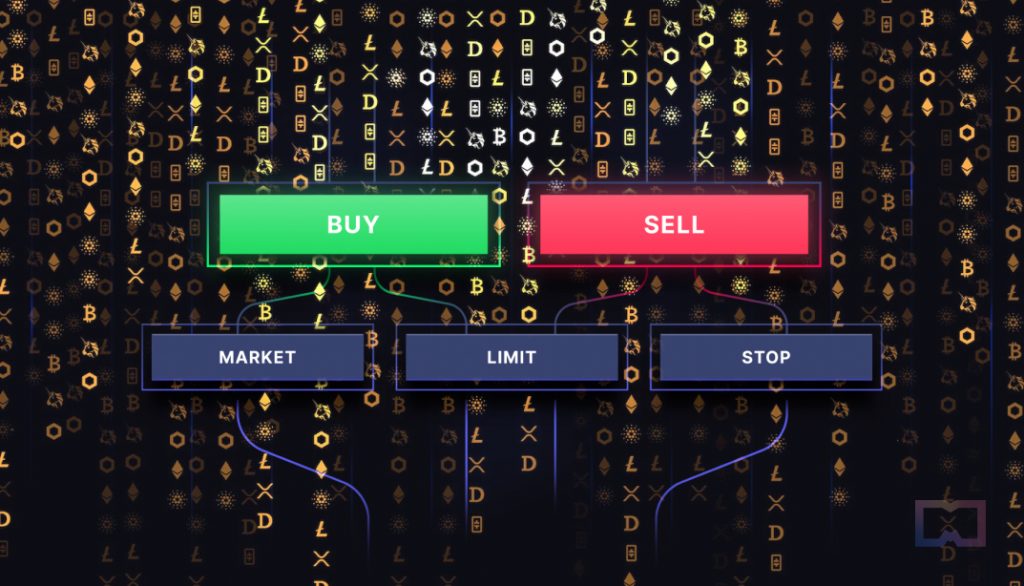Crypto trading basics: Introduction to cryptocurrency order types 2023
In Brief
In cryptocurrency trading, order types are used to specify the conditions under which a trade should be executed.
Some of the most common order types used in crypto trading are limit orders, market orders, and stop-limit orders.
Introduction
If you’re new to cryptocurrency trading, the vast array of available order types can be confusing and intimidating. To help you get started, we’ve compiled a list of the most common order types, along with a brief explanation of each.

Market Order
A market order is the simplest and most common type of order. When you place a market order, you are instructing your broker to buy or sell an asset at the best available price in the current market. For example, let’s say you want to buy 1 BTC at the current market price. You would place a market buy order, and your broker would execute the trade at the best available price. In this case, the best available price is the current market price of BTC.
Market orders are often used when investors want to buy or sell an asset quickly and don’t mind paying a slightly higher price for convenience.
Pros:
- Simple to execute.
- Ideal for buying or selling cryptocurrencies quickly.
Cons:
- You will pay a higher price for the cryptocurrency if you are buying, or receive a lower price if you are selling, due to the market conditions at the time of execution.
Limit Order
A limit order is an order to buy or sell an asset at a specific price. Unlike a market order, a limit order will not be executed immediately. Instead, it will remain open until the specified price is reached. Let’s say you want to buy 1 BTC when the price reaches $10,000. You would place a limit buy order for 1 BTC at $10,000, and your order would remain open until the BTC price reaches $10,000. Once the price of BTC hits $10,000, your order will be executed, and you will own 1 BTC.
Limit orders are often used by investors who want to buy or sell an asset at a specific price. They can also be used to limit losses in a falling market.
Pros:
- You can specify the exact price at which you want to buy or sell a cryptocurrency.
- Ideal for traders who want to buy or sell at a specific price.
Cons:
- Your order may not be executed if the market conditions are not favorable.
- You may have to wait a long time for your order to be executed.
Stop-Loss Order
A stop-loss order is an order to buy or sell an asset once it reaches a certain price. Unlike a limit order, a stop loss order is not open until the specified price is reached. Instead, it becomes active once the stop price is reached and will be executed at the best available price.
For example, let’s say you want to buy 1 BTC when the price reaches $10,000. You would place a stop-loss buy order for 1 BTC at $10,000. Once the BTC price hits $10,000, your order will become active and will be executed at the best available price.
Stop-loss orders are often used by investors who want to limit their losses in a falling market.
Pros:
- You can specify the exact price at which you want to buy or sell a cryptocurrency.
- Ideal for traders who want to buy or sell at a specific price.
Cons:
- Your order may not be executed if the market conditions are not favorable.
- You may have to wait a long time for your order to be executed.
Take-Profit Order
A take-profit order is an order to buy or sell an asset once it reaches a certain price. Unlike a limit order, a take-profit order is not open until the specified price is reached. Instead, it becomes active once the take profit price is reached and will be executed at the best available price.
For example, let’s say you want to buy 1 BTC when the price reaches $10,000. You would place a take-profit buy order for 1 BTC at $10,000. Once the BTC price hits $10,000, your order will become active and will be executed at the best available price.
Take-profit orders are often used by investors who want to take profits in a rising market.
Pros:
- It allows you to set a specific target price and walk away from your computer while the trade is executed automatically.
- It can be used in combination with a stop-loss order to limit your losses.
Cons:
- You may miss out on profits if the price rises further after reaching your target.
- Not available on all exchanges.
How to set up a cryptocurrency exchange account
The first step in trading cryptocurrencies is to set up an account on a cryptocurrency exchange. There are many different exchanges available, so it is important to select one that is reputable and offers the features that you need.
Once you have selected an exchange, you will need to create an account. This process usually requires you to provide some personal information, such as your name and email address. You will also need to create a password. The process also requires identity verification. This usually involves uploading some form of identification, such as a passport or driver’s license. Once your identity has been verified, you will be able to deposit funds into your account and start trading.
Steps to make an order
To start trading cryptocurrencies, you first need to set up an account on a cryptocurrency exchange. Once you have done this, you will be able to access the exchange’s trading platform and make your first trade.
The process of making a trade on a cryptocurrency exchange is relatively simple. First, you need to select the cryptocurrency pair that you want to trade. For example, if you want to trade Bitcoin for Ethereum, you would select the BTC/ETH pair.
Once you have selected the pair that you want to trade, you need to choose what type of order you want to make.
Fundamental analysis vs. technical analysis
What’s the difference?
When it comes to analyzing cryptocurrency markets, there are two main approaches that traders use: fundamental analysis and technical analysis. Fundamental analysis is a method of evaluating an asset by looking at its underlying economic, financial, and political conditions. Technical analysis, on the other hand, is a method of analyzing price charts and trends to identify trading opportunities.
So, which approach is better?
Well, that depends on your trading goals and objectives. If you’re looking to invest in a cryptocurrency for the long term, then you’ll likely want to focus on fundamental analysis. But if you’re looking to trade cryptocurrencies for short-term profits, then technical analysis may be a better approach.
Of course, you don’t have to choose one approach over the other. Many traders use both fundamental and technical analysis when making trading decisions.
The bottom line is that there is no right or wrong way to analyze cryptocurrency markets. It’s all about finding what works best for you and your trading style.
FAQs
Most exchanges require you to create an account before placing an order. Once you have done so, you will generally need to deposit some fiat currency (e.g., USD) or cryptocurrency to start trading.
Once you have deposited funds, you will be able to browse the exchange’s selection of trading pairs (e.g., BTC/ETH) and place an order using the exchange’s order form. Depending on the exchange, you may be able to place a limit order, market order, or stop-limit order.
A limit order is an order to buy or sell a cryptocurrency at a specified price or better. A buy-limit order will only be executed at the specified price or lower, while a sell-limit order will only be executed at the specified price or higher.
Limit orders are often used by traders who want to ensure that they get the best possible price for their trade.
A market order is an order to buy or sell a cryptocurrency at the best available price. Market orders are often used by traders who want to get their trade executed as quickly as possible without worrying about the price.
A stop-limit order is an order to buy or sell a cryptocurrency at a specified price or better after a specified price has been reached. Stop-limit orders are often used by traders who want to limit their losses on a trade.
If you want to cancel an order that you have placed on an exchange, you will need to go to the order book for the relevant trading pair and cancel your order there. Canceling an order on an exchange is generally a simple process, but it may vary depending on the exchange you are using.
If your order is a limit order, it may not be executed immediately if the price of the cryptocurrency you are trying to buy or sell is not currently at your specified price. In this case, your order will remain in the order book until the price of the cryptocurrency reaches your specified price or until you cancel it.
The fees associated with trading cryptocurrencies vary from exchange to exchange. Some exchanges charge a flat fee for all trades, while others charge different fees for different types of orders. You should always check the fees charged by an exchange before you place an order.
The risks associated with trading cryptocurrencies include loss, theft, and fraud. When trading cryptocurrencies, you should always take precautions to protect yourself from these risks. For example, you should keep your private keys safe and secure, and you should only trade on exchanges that have a good reputation.
The benefits of trading cryptocurrencies include the potential to make money, the ability to diversify your investment portfolio, and the opportunity to trade in a new and exciting market.
Cryptocurrency arbitrage is the act of buying and selling cryptocurrencies on different exchanges to profit from the price differences between the exchanges. Arbitrage opportunities can arise when there are price differences between different exchanges for the same cryptocurrency. For example, if one exchange is selling Bitcoin for $10,000 and another exchange is selling Bitcoin for $9,500, a trader could buy Bitcoin on the first exchange and sell it on the second exchange for a profit of $500.
Margin trading is a type of trading that allows you to trade with more money than you have in your account. When you margin trade, you borrow money from an exchange or broker to trade with. Margin trading can be a risky strategy, as it can amplify both your profits and your losses. However, if done correctly, it can be a profitable way to trade on the cryptocurrency market.
Short selling is a type of trading that allows you to profit from falling prices. When you short-sell, you borrow a cryptocurrency from an exchange or broker and sell it, hoping that the price will fall so that you can buy it back at a lower price and return it to the lender.
A stop-loss order is an order that you place to sell a cryptocurrency when it reaches a certain price. Stop-loss orders are used to limit your losses in a falling market. For example, if you bought Bitcoin at $10,000 and placed a stop-loss order at $9,500, your order would be executed if the price of Bitcoin fell to $9,500 and you would sell your Bitcoin for a $500 loss.
Conclusion
In conclusion, understanding different order types is essential for successful crypto trading. Market orders are the simplest order type and are filled quickly, while limit and stop-limit orders allow traders to set specific prices for their trades. Knowing which order type is best suited for each situation can help traders achieve their desired price points and reach their financial goals.
Related articles
- What is Bitcoin Cash, and how does BCH work? A beginner’s guide
- Altcoin exchange 101:A comprehensive guide on how to buy and sell altcoins
- Bitcoin supporter Anthony Pompliano is losing confidence in cryptocurrencies as the market continues to slid
Disclaimer
In line with the Trust Project guidelines, please note that the information provided on this page is not intended to be and should not be interpreted as legal, tax, investment, financial, or any other form of advice. It is important to only invest what you can afford to lose and to seek independent financial advice if you have any doubts. For further information, we suggest referring to the terms and conditions as well as the help and support pages provided by the issuer or advertiser. MetaversePost is committed to accurate, unbiased reporting, but market conditions are subject to change without notice.
About The Author
Moses is an experienced freelance writer and analyst with a keen interest in how technology is disrupting the financial sector. He has written extensively on the subject of cryptocurrencies from an investment perspective, as well as from a technical standpoint. He has also been involved in trading cryptocurrencies for over two years.
More articlesMoses is an experienced freelance writer and analyst with a keen interest in how technology is disrupting the financial sector. He has written extensively on the subject of cryptocurrencies from an investment perspective, as well as from a technical standpoint. He has also been involved in trading cryptocurrencies for over two years.


















































